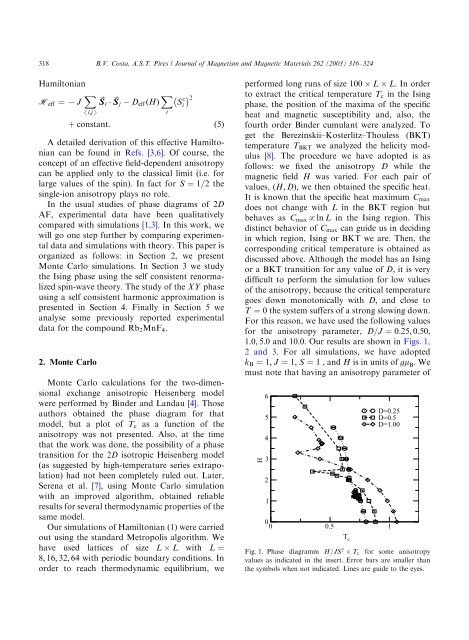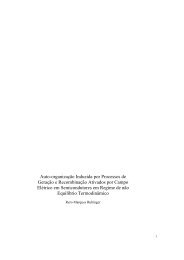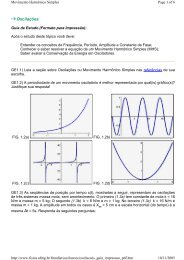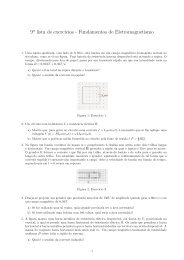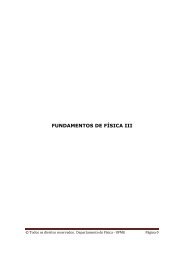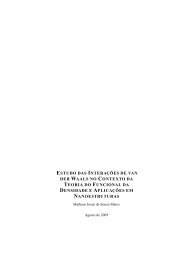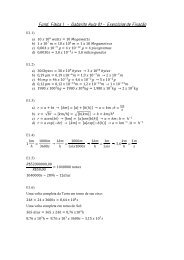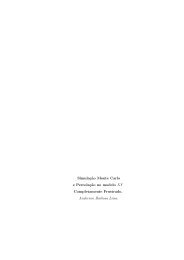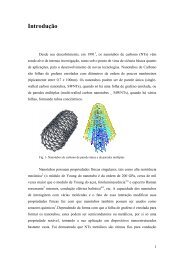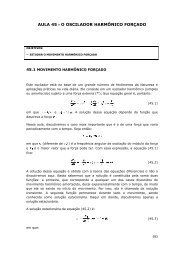Phase diagrams of a two-dimensional Heisenberg antiferromagnet ...
Phase diagrams of a two-dimensional Heisenberg antiferromagnet ...
Phase diagrams of a two-dimensional Heisenberg antiferromagnet ...
You also want an ePaper? Increase the reach of your titles
YUMPU automatically turns print PDFs into web optimized ePapers that Google loves.
318B.V. Costa, A.S.T. Pires / Journal <strong>of</strong> Magnetism and Magnetic Materials 262 (2003) 316–324HamiltonianH eff ¼J X /i;jSþ constant:~S i ~ S j D eff ðHÞ X iSiz 2ð5ÞA detailed derivation <strong>of</strong> this effective Hamiltoniancan be found in Refs. [3,6]. Of course, theconcept <strong>of</strong> an effective field-dependent anisotropycan be applied only to the classical limit (i.e. forlarge values <strong>of</strong> the spin). In fact for S ¼ 1=2 thesingle-ion anisotropy plays no role.In the usual studies <strong>of</strong> phase <strong>diagrams</strong> <strong>of</strong> 2DAF, experimental data have been qualitativelycompared with simulations [1,3]. In this work, wewill go one step further by comparing experimentaldata and simulations with theory. This paper isorganized as follows: in Section 2, we presentMonte Carlo simulations. In Section 3 we studythe Ising phase using the self consistent renormalizedspin-wave theory. The study <strong>of</strong> the XY phaseusing a self consistent harmonic approximation ispresented in Section 4. Finally in Section 5 weanalyse some previously reported experimentaldata for the compound Rb 2 MnF 4 :2. Monte CarloMonte Carlo calculations for the <strong>two</strong>-<strong>dimensional</strong>exchange anisotropic <strong>Heisenberg</strong> modelwere performed by Binder and Landau [4]. Thoseauthors obtained the phase diagram for thatmodel, but a plot <strong>of</strong> T c as a function <strong>of</strong> theanisotropy was not presented. Also, at the timethat the work was done, the possibility <strong>of</strong> a phasetransition for the 2D isotropic <strong>Heisenberg</strong> model(as suggested by high-temperature series extrapolation)had not been completely ruled out. Later,Serena et al. [7], using Monte Carlo simulationwith an improved algorithm, obtained reliableresults for several thermodynamic properties <strong>of</strong> thesame model.Our simulations <strong>of</strong> Hamiltonian (1) were carriedout using the standard Metropolis algorithm. Wehave used lattices <strong>of</strong> size L L with L ¼8; 16; 32; 64 with periodic boundary conditions. Inorder to reach thermodynamic equilibrium, weperformed long runs <strong>of</strong> size 100 L L: In orderto extract the critical temperature T c in the Isingphase, the position <strong>of</strong> the maxima <strong>of</strong> the specificheat and magnetic susceptibility and, also, thefourth order Binder cumulant were analyzed. Toget the Berezinskii–Kosterlitz–Thouless (BKT)temperature T BKT we analyzed the helicity modulus[8]. The procedure we have adopted is asfollows: we fixed the anisotropy D while themagnetic field H was varied. For each pair <strong>of</strong>values, ðH; DÞ; we then obtained the specific heat.It is known that the specific heat maximum C maxdoes not change with L in the BKT region butbehaves as C max pln L in the Ising region. Thisdistinct behavior <strong>of</strong> C max can guide us in decidingin which region, Ising or BKT we are. Then, thecorresponding critical temperature is obtained asdiscussed above. Although the model has an Isingor a BKT transition for any value <strong>of</strong> D; it is verydifficult to perform the simulation for low values<strong>of</strong> the anisotropy, because the critical temperaturegoes down monotonically with D; and close toT ¼ 0 the system suffers <strong>of</strong> a strong slowing down.For this reason, we have used the following valuesfor the anisotropy parameter, D=J ¼ 0:25; 0:50;1:0; 5:0 and 10:0: Our results are shown in Figs. 1,2 and 3. For all simulations, we have adoptedk B ¼ 1; J ¼ 1; S ¼ 1 , and H is in units <strong>of</strong> gm B : Wemust note that having an anisotropy parameter <strong>of</strong>H65432100 0.5 1T cD=0.25D=0.5D=1.00Fig. 1. <strong>Phase</strong> diagramm H=JS 2 T c for some anisotropyvalues as indicated in the insert. Error bars are smaller thanthe symbols when not indicated. Lines are guide to the eyes.


